Moïse et Pharaon, ou Le passage de la mer rouge is Rossini’s adaptation of his Neapolitan Mosè in Egitto for the Paris Opéra. This revision may be the epitome of all opera. Photo: Eleonora Buratto as Anaï, Roberto Tagliavini as Moses.
Plus Elisabetta, Regina d’Inghilterra, Rossini’s « audition » for more tragedies in Italy’s most important theater, Naples’ Teatro San Carlo, and Il Signor Bruschino, a failed farce composed just before the dawn of Rossini’s fame and fortune.
Il Signor Bruschino, ovvero il figlio per azzardo was last staged at the Pesaro festival in 2012 by Teatro Sotterraneo, a theater collective who by committee effort effected the farce in a “Rossiniland” theme park. It was bedlam. This time it was staged by the Canadian design/director team Barbe and Doucet (André Barbe and Renaud Doucet) who somehow connected Il Signor Bruschino to Guignol theater’s Il tabarro, setting Rossini’s country house farce on a river barge named “Il Mio Castello” even though there were no bloody murders thereupon.
The farce itself is off the wall. Signor Bruschino, being swindled, refuses to recognize a pretend son until doing so swindles the guardian of his real son’s fiancé. That true love may triumph isn’t nearly as important as winning. These days Rossini critics are delighted by the musical witticisms spread through the score, starting with the second violins tapping their music stands with their bows during the overture (in the moment one did wonder what had gone wrong to make all that racket).
There are indeed many musical rewards, among them a fine trio for three buffos — the father, the guardian and the innkeeper (who has imprisoned Bruschino’s son). There was as well a brief, miniature finale-scaled ensemble (five voices), a fine duet extolling the value of marriage to the conniving ingenue, a spectacular aria for the ingenue in splendid duet with an English horn and finally a plethora of patter pieces. The great Rossini comedies are just around the corner.
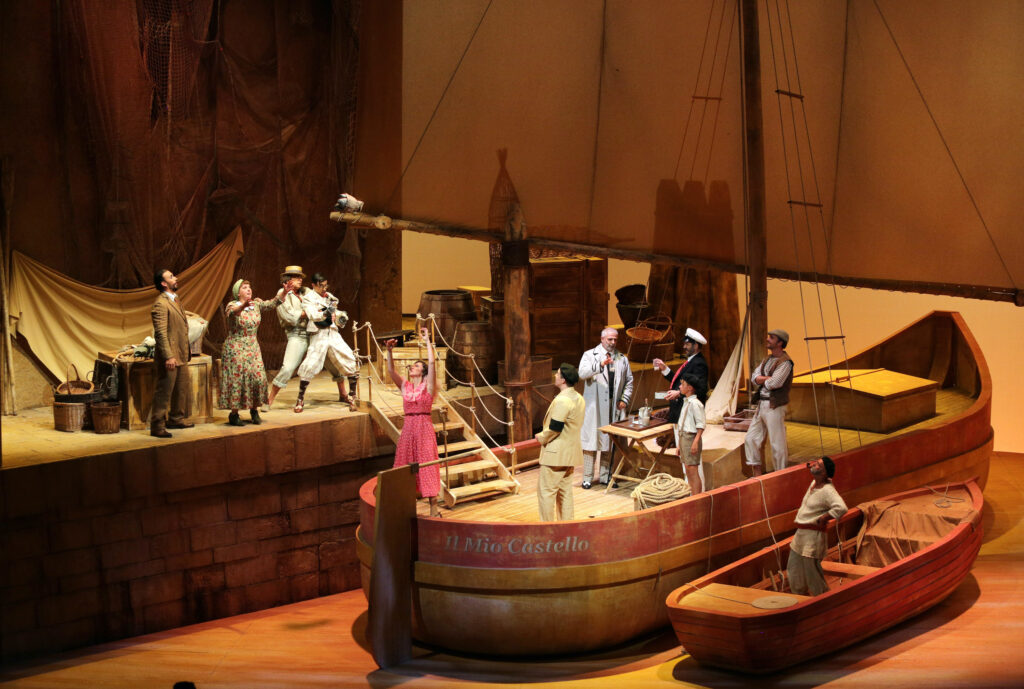
Vocally the challenges were very well met. Signor Bruschino himself was enacted by veteran Italian buffo bass Pietro Spagnoli, his counterpart Gaudenzio, the guardian, was sung by Giorgio Caoduro who executed really fine, dignified patter, the innkeeper Filoberto was broadly enacted by Gianluca Margheri — voilà the buffo trio! The swindler lovesick swain was stylishly sung by American tenor Jack Swanson, his now fiancé Sofia well sung by Spanish soprano Marina Monzó (an alumna of the festival’s young artist program). Roles facilitating the action were the Commisario sung by Enrico Iviglia and Marianna sung by Chiara Tirotta. The cameo role of the real Signor Bruschino junior was Manuel Amati.
Barbe and Doucet gave a straight forward accounting of the farce, the three levels of the very pretty set (left to right the high dock, the lower barge deck, and finally an auxiliary rowboat (whose tippiness provided just the right amount of provocation) serving as alternating stages for Rossini’s nifty musical procession. After the chaos of the 2012 production it was a quite tame and responsible solution for the farce, set on a barge, there, on the river of life [maybe?].
I’ll Signor Bruschino was performed in the 850 seat Teatro Rossini, pandemically reconfigured by placing all the spectators in two of the four seats of the horseshoe theater boxes (about a hundred of them) leaving the entire orchestra seating area to the orchestra. Amply spread out in concert formation we were able to admire an early Rossini’s score, as never before (a manuscript edition was clearly visible on the music stands). Many of us had clear sight of young conductor Michele Spotti who lived every moment of Rossini’s pre-maturity in a just and lively fashion. FYI Daniele Rustioni was the conductor for the 2012 version.
Elisabetta, Regina d’Inghilterra
Strangely the 15,000 seat Vitrofrigo Arena in Pesaro becomes one of the world’s great opera theaters for a month each summer (Vitrifrigo makes refrigerators for boats). Normally the festival configures a 1200 seat auditorium on the basketball court floor and erects a full stage house on one end complete with traps, flies and wings. Over the years (since 2005) the acoustic has been perfected, the leaky roof not a problem as there has been little rain.
Configured for the pandemic only 500 audience places were made available, leaving ample space to seat the Orchestra Sinfonica Nazionale della RAI in concert formation. Conductor Evelino Pidò exploited the greater resonance and orchestral presence for Elisabetta, Regina d’Inglilterra (1815) extracting great breadth of phrase and depth of tone. Rossini originally composed its overture for Aureliano in Palmira (1813), though it is far better known as the quite lively overture to the Barber of Seville (1816).
Elisabetta was a great success back in 1815, paving the way for Rossini’s famous Neapolitan opera seria‘s, notably Otello (1816) and Mosé in Egitto (1818). Elisabetta (who not-so-secretly loves the secretly-married-to-someone-else Leicester) has the first great aria of the tragedy “Quant’è grato all’alma mia,” its cabaletta now far better known in its later, recycled version as that of Barber’s “Una voce poco fa.”
Norfolk betrays Leicester’s secret marriage, Elisabetta condemns everyone to death. In the spirit of the day it all ends quite happily. So was it a tragedy after all? Distinguished Italian stage director Davide Livermore (dah-vee-day lee-ver-mor-aye) didn’t take it a bit seriously, after all this is the period of the great Rossini Roman comedies.
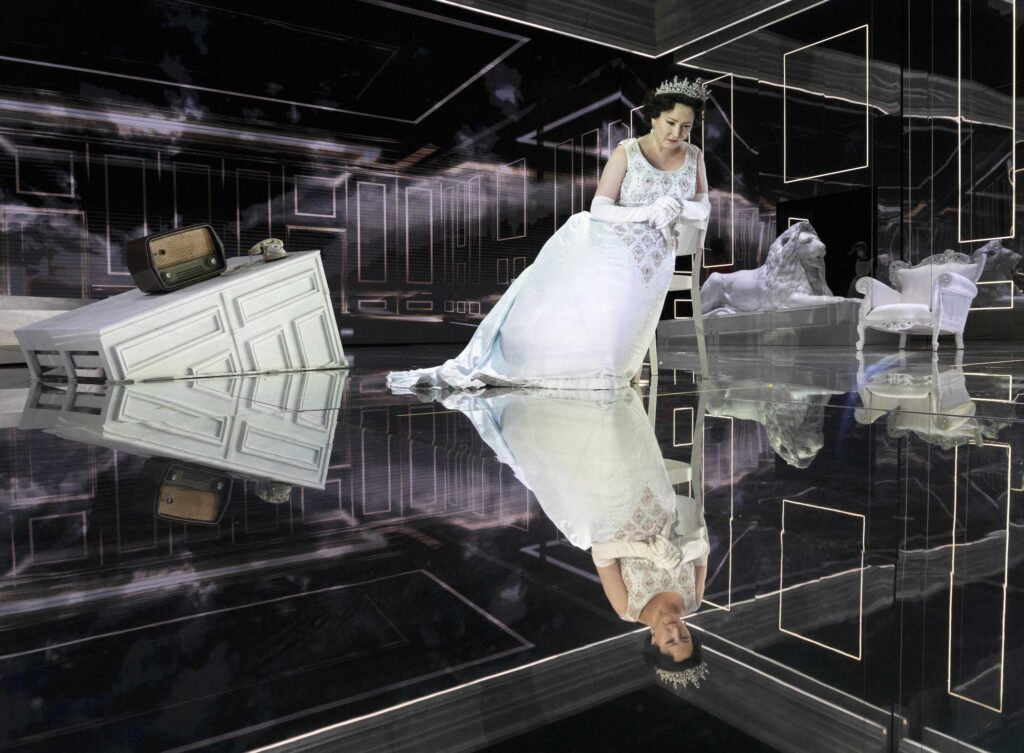
Sig. Livermore imposed a highly abstract, maximally sophisticated, thoroughly cartoonized theatrical language that had far more to do with the technical challenges of pulling it off than it did with finding a life for Rossini’s formulaic emotions. It was a tour de force staging, starting with the tromp l’oeil stage picture that defied any possible definition of space thanks to impressive tricks of video, lasers and mirrors. Raging fires, violent storms, heavy clouds raced through the space reminding us that the background of the story is the Earl of Leicester’s glorious defeat of Mary Queen of Scots’ forces that has made the Duke of Norfolk so jealous of Leicester, and that emotions do indeed run amuck.
There really wasn’t much room for Rossini’s music, try as Mo. Pidò might with the responsive Orchestra Sinfonica Nationale della RAI. He exaggerated Rossini’s musical structures in sustained lines that slowed the dramatic pulse, further contributing to the monotony of the performance.
When the constant video commentary was less violent and things calmed down a bit with the lasers fooling our eyes, four witty, stock maids and four stock, goose-stepping palace guards executed sharply geometric choreography in perfect synchrony with Rossini’s musical structures, the principals moving much in the same fashion. The visual mirroring of the music was particularly tiresome in the what-seemed-to-be interminable recitatives.
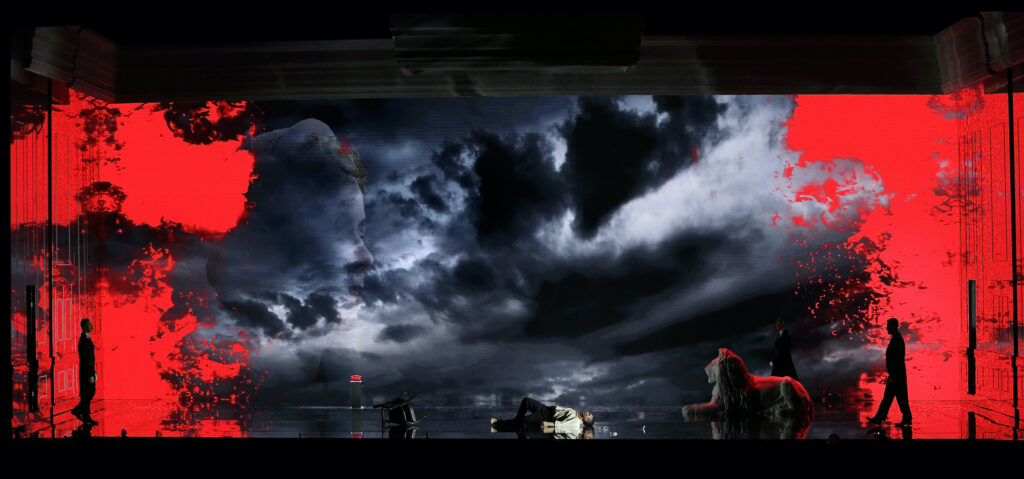
In the dramatic climax of the story the Duke of Norfolk rushes out to stab the queen only to be thwarted by Leicester. I confess I missed this greatly anticipated moment (quieting once and for all Leicester’s arch enemy), evidently having zoned out.
Elisabetta was brilliantly sung by French diva Karine Deshayes though in a smaller scaled voice than many recent Elisabettas. She looked very much like the official mid-life portraits of Elizabeth II. The Duke of Norfolk was performed by British tenor Barry Banks looking very much like Winston Churchill, his character tenor voice and presentation allowing no dignity (or authenticity) whatsoever to Norfolk’s treachery. No discernible rationale can be imagined for these two political/historical references.
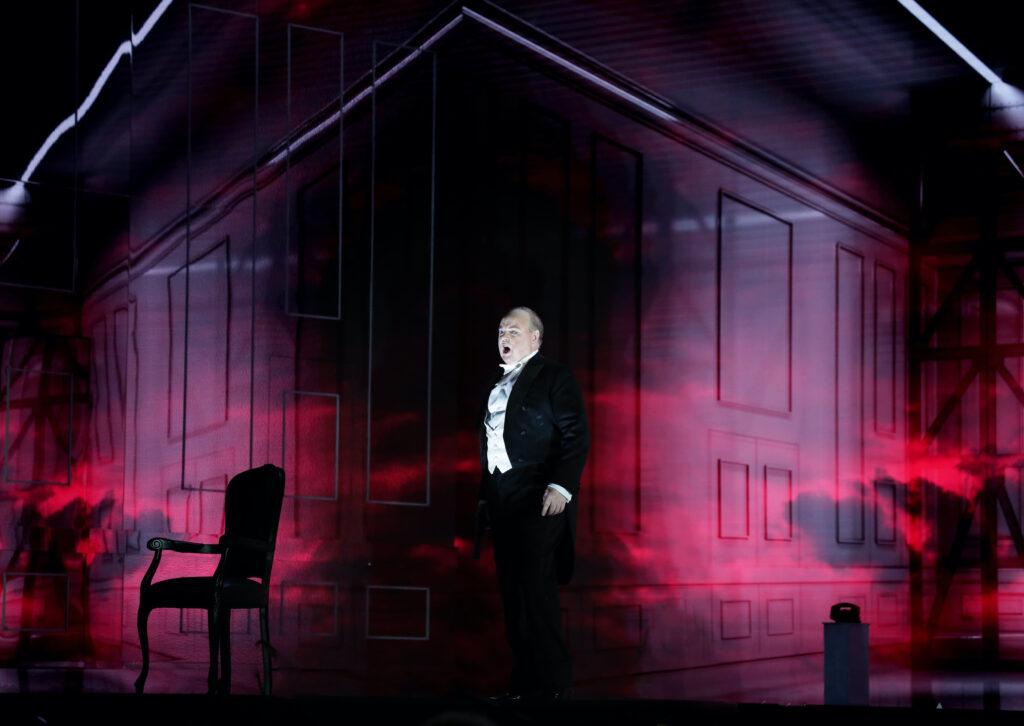
Much less colorful was the rather wooden Leicester sung by Russian tenor Sergey Romanovsky. As Leicester’s secret bride Matilde Georgian born, Italian finished soprano Salome Jicia shone in her beautifully sung Act I aria “Sento un’interna voce.” Matilde’s brother Enrico was sung by mezzo soprano Marta Pluda, a recent participant in the ROF young artist program. Baritone Valentino Buzza was the Guglielmo, a role of actual dramatic importance but of no interest to stage director Livermore.
Moïse et Pharaon
Of great interest however, and of very great pleasure was Rossini’s remake of Naple’s Mosè in Egitto (1818) for the Paris Opéra, then known as the Académie royale de Musique. Mosè in Egitto itself was first performed at Paris’ Théâtre-Italien in 1822, its French version appearing in 1827, renamed Moïse et Pharaon, thus giving greater presence to the opera’s antagonist, the king of Egypt, called Pharaon (pharaoh in English, faraone in Italian) — there is no further biblical name in the Book of Exodus.
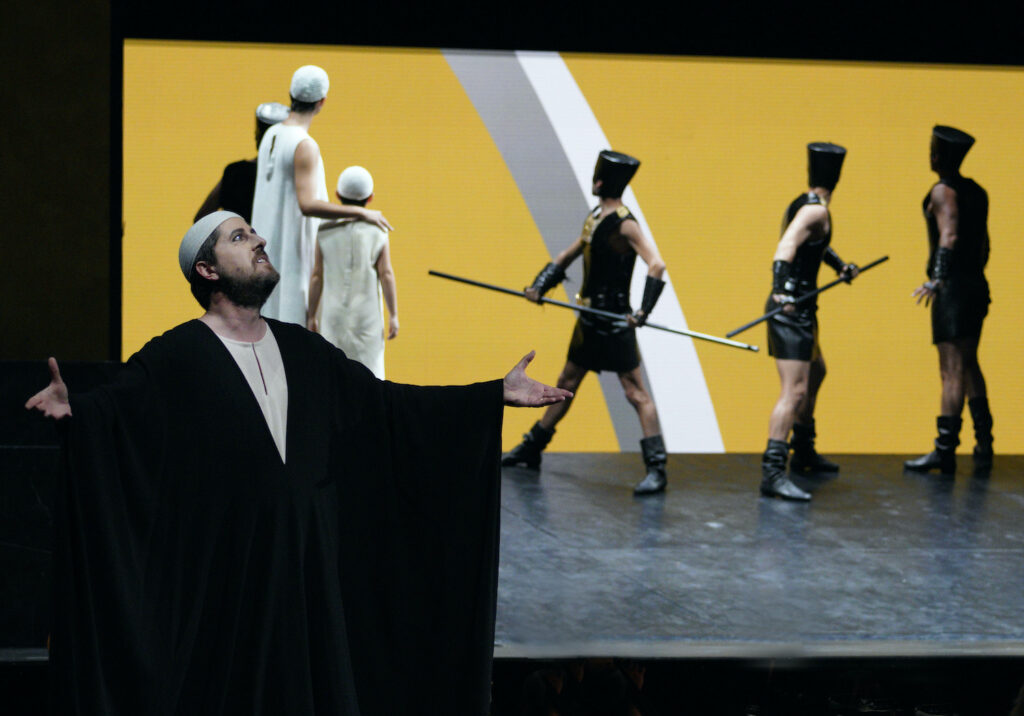
Expected in the revision was the purging of many arias, florid singing less valued in the early moments of French grand opera, and the addition of dance, much valued in French court theater. There was a brief dance moment in Act I, and an extended dance sequence in Act III (three Airs de dances) with impressive music (and excellent dancing) that held our interest for thirty or so minutes already quite late in the evening.
Spectacle too was valued at the Opéra, thus the impressive addition of biblical phenomenon in Act 1. The Israelites rejoice, “Oh jour heureux, jour solennel,” in learning that Pharaon will allow them to leave, God himself joins in creating a giant rainbow, He flames a bush that does not burn, Moses receives the Ten Commandments. It was awe inspiring indeed, both musically and visually. And that wasn’t all. The act concludes when God darkens the sky, collapses the great pyramid rendering it a volcano, all this in an eight voice finale with chorus. It was awesome. Grand opera loves spectacle!
A finale of even greater effect was “Je réclaim la foi promise,” new for the Opéra, in which the nine solo voices of the opera convene at the end of Act III, together with the Egyptians and Israelites to plead the release of the Israelites (Pharaon had reneged his Act I promise). The sacred Egyptian flames extinguish, the statue of Isis crumbles, the Ark of the Covenant appears, and the pharaoh decrees that the Israelites be released into the desert, all this to a repeating ascending bass line, rising each repetition first by a minor third, then a major third while the upper lines descend chromatically. The house came down, ignorant of such musical analysis.
Act I was newly created for the Opéra, except the duet when Anaï (Moses’ nice) tells Aménophis (Pharoan’s son) that though she loves him she loves her God and family more (this of course is the root of all the opera’s disasters). There are several more superb duets that occur throughout the opera, many with the mezzo soprano Marie (Anaï’s mother), a voice that was to find particular favor in French grand opera.
There were harp accompanied chorus scenes of invocation and prayers in each act, especially noteworthy was the justly famous, gorgeous Act IV chorus “Des cieux oû tu résides” where Moses sings the first strophe (harp accompaniment) repeated by the chorus, his brother Éliézer sings the second, repeated by the chorus, Anaî the third, then in a sudden modulation to a major key all voices sing together. It was a musical prayer of absolute and exquisite beauty.
Though all important voices had at least one brief solo air, there were two major aria scenes. The mother of Aménophis, Sinaïde, begs her son to marry a princess of his own rank in an extended scene that closes Act II. Her aria “Ah! d’une tendre mère” is interspersed with recitatives with her reluctant son, and includes opportunities for her to exhibit hugely virtuoso coloratura before concluding with a triumphant cabaletta.
And finally, in the dramatic conclusion to Act IV (though later the Red Sea does part for the Israelites to pass before it swallows the Egyptians, and there is a final encomium as well) Anaï sings her “Quelle horrible distinée!,” newly composed for the Opéra in which Rossini pulls out all the stops possible in an aria — sustained cantabile, florid passages, and declamations that leap to distant intervals. It is a very difficult, splendid piece indeed, worthy to be the vocal crown of this amazing opera, perhaps of the Rossini canon.
The just over four hour evening (one brief interval) was held together by the superb conducting of Giacomo Sagripanti who sustained an unfaltering musical tension that connected the prayers to the spectacles, the arias to the ensembles to the enormous finales. It was a conducting tour de force, coaxing rich tone and mighty musical excitement from the Orchestra Sinfonica Nationale della RAI, moving from tormented individuals to tormented throngs ultimately to a rarified celestial peace that ultimately portends hope for mankind.
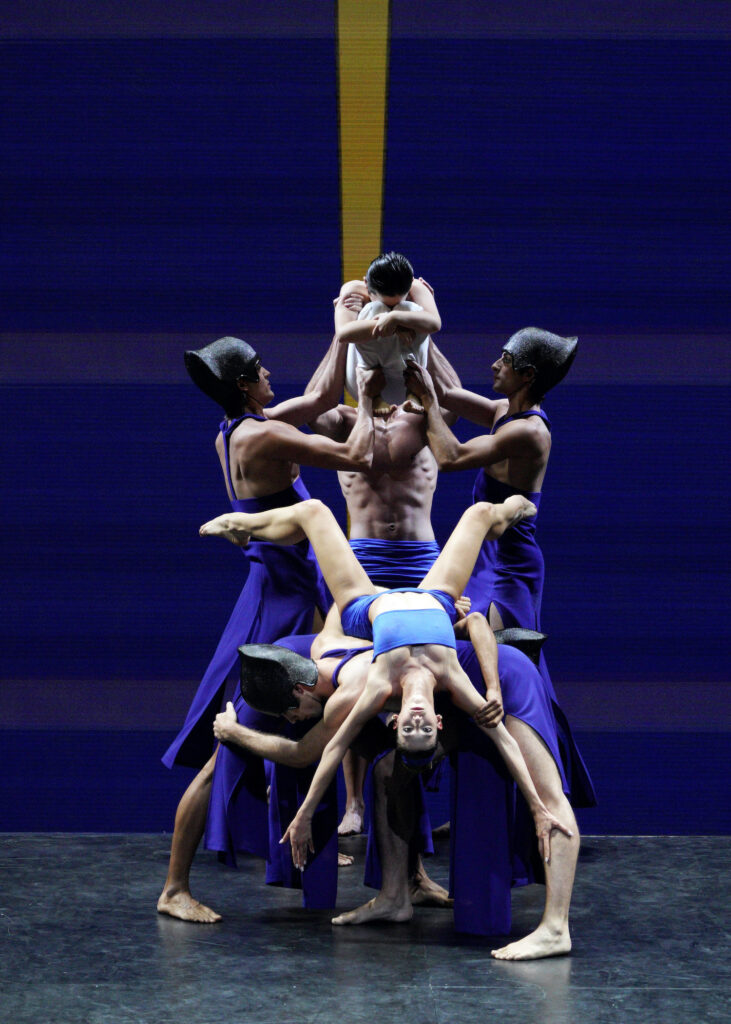
The opera was staged by 91 year old Pier Luigi Pizzi, a veteran designer/stage director of the world’s great theaters. His concept seems to have been that since Rossini refined his Mosè in Egitto to become Moïse et Pharaon, surely his most musically refined opera, he, Pizzi, would refine its staging to the purest form possible. Thus the stage itself was a floor and a wall that parted to reveal a blank space in which abstracted spectacle was placed or projected. Of great importance was a stage apron that surrounded the orchestra upon which principals often descended to directly sing to the spectators. No scenery, just the singer, Rossini, and you. But not always. The huge Act III finale brought all nine singers across the apron, obliterating the orchestra, to create musical excitement that grew to mammoth proportion, well beyond human scope (you had to be there to know that you could survive it).
Pier Luigi Pizzi was a minimalist long before minimalism became fashionable. Here, with Rossini’s massive score the minimalism became architectural brutalism, its weighty materials molded into purest form.
Sig. Pizzi opened his staging of the opera with the appearance of a young boy dressed in white who then reappeared in the final tableau, the Cantique (hymn) “Chantons, benisons le Seigneur!” This encomium sung now that the Jews have reached the promised land. The walls were now hidden leaving only the dark silhouettes of the Jews against the clear and empty space where God’s earthly spectacles had taken place. At the last moment of the opera four dancers raised the white-clothed boy in offering.

The excellent chorus was that of Ascoli Piceno’s (a nearby town) theater, the Teatro Ventidio Basso [Publio Ventidio Basso was a local hero in Roman times who became a consul!]. Since becoming the main chorus for the ROF in 2017 the Coro del Teatro Ventdio Basso has assumed considerable artistic stature.
The choreographer was Romanian born, Bolshoi finished Gheorghe Iancu, a longtime Pizzi collaborator. His dancers were four movement mimes, four ballerinos, and a male and female principal dancer, nearly all of La Scala provenance. The Act III ballet sequence was effected in mostly basic classical balletic steps, the four male dancers in unisex costume often executing movements normally associated with ballerinas, the soloists often in grand pas de deux, Egyptian frieze informed movement and then in breathtaking lifts. In short, it was awesome.
Baritone Roberto Tagliavini sang a Moses of powerful dignity, his voice achieving supernatural beauty in the Act IV prayer. Bass-baritone Erwin Schrott sang Pharaon in pontifical tones that shook the walls. He obviously was having the time of his life here in Rossini heaven. Soprano Eleonora Buratto sang Anaï, at first her full lyric voice seemed out of place though in the great final aria she shone in uncommon virtuosity — flawless coloratura, finding precise intonation in staggering leaps. Soprano Vasilisa Berzranskaya sang Sinaïde, her great Act II aria earning one of Pesaro’s tumultuous multi-minutes, foot stomping ovations. Tenorino Alexey Tatarintsev sang Mose’s brother Èliézer in unusually smooth and warm tones for this voice. Tenorino Andrew Owens sang Aménophis in biting tone appropriate to this villainous role. Mezzo-soprano Monica Bacelli sang Anaï’s mother Marie affecting appropriate maternal maturity, and Matteo Roma sang the irascible Egyptian priest Aufide. Nicolò Donini sang the offstage mysterious voice.
Massimo Gasparon was the associate stage director, effecting as well impressive lighting.
Michael Milenski
P.S. If you got this far you may be interested in my review of the late Graham Vick’s production of Mosè in Egitto performed in Pesaro in 2011. It is a horse of a different color.
All photos courtesy of the Rossini Opera Festival copyright ROF / Studio Amati Bacciardi